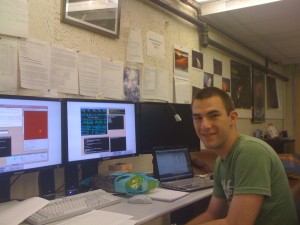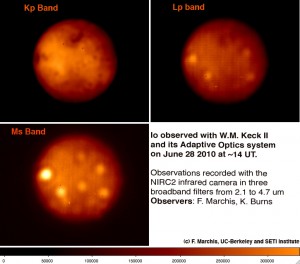Keck AO Observations: Io Volcanism – "Mornes plaines"
AIDA: A Projects Day at Harvey Mudd College
June 2, 2010Keck AO Observations: Multiple Asteroid Systems
July 20, 2010It has been a while I did not write anything on this blog. As usual I am late on reporting some news in the world of astronomy. Today I decided to write a short post on observations that we did using the Keck telescope and its AO system about Io.
Like last year, my summer is busy with the REU students of the SETI Institute. I will write a specific post on two students who are working with me and their project in a few days.
I obtained telescope time at the end of June 2010 with the W.M. Keck II telescope and its Adaptive Optics system. Because I could not afford to travel to the Big Island, I decided to conduct these observations from UC-Berkeley, using a dedicated remote control room in the basement of our building. Keaton Burns, one of my REU students, was also there and helped me during these observations. Interestingly, it was his first observation run with an optical telescope. Starting as a newbie with the largest telescope in the world, I am hoping he is not going to get bored too quickly. 🙂

Keaton Burns, SETI-REU student in the remote control room at UC-Berkeley, shortly before the beginning of the observations.
As usual with the W.M. Keck telescope, the night went smoothly even if it was quite intensive. We observed 40 targets (mostly asteroids) with an excellent seeing (~0.7″) and sky transparency. We are very fortunate to be able to conduct observations from this exceptional site. Mauna Kea is definitely one of the best sites for astronomy. I should also thank our telescope operator (Julie) and our AO support (Hien Tran) for their first class support and their help during this night.
During our night, we took a break of observing asteroids (we are searching for moons around them) and pointed the Keck telescope toward Io. Io, the innermost satellite of Jupiter, is well known for its intensive volcanism. Using AO systems, we use the exquisite angular resolution provided by these instruments mounted on 8-10m class telescopes to monitor its volcanic activity. Our spatial resolution remains limited (~125 km), so we do not see the volcanoes themselves but the thermal output of the fresh magma being erupted.
I am attaching below three images of Io taken at 2.1 um (Kp), 3.8 um (Lp) and 4.7 um (Ms). At longer wavelength range, you can see more active volcanoes(bright dots on the images) since we are sensitive to lower magma temperature.
On the top of monitoring the active volcanoes on Io, to determine their temperature and their surface area, we were hoping to capture a high temperature volcano (an outburst) like we saw in Feb 2001 for instance. These extremely energetic eruptions are detectable at shorter wavelength (<2 um) and help determining the highest magma temperature. Io, however, decided to be quite boring in June. On this hemisphere we could detect only 4 volcanoes in Lp and Ms band (most likely: Pillan, Marduk, Prometheus and Zamama), and we noticed the absence of activity in K band.
The tough reality of being a planetary astronomers: we can’t make a major discovery, each time we observe… 🙁
More soon about this observing run on this blog.




1 Comment
Your work is great! Monitoring Io’s volcanic activity is worth the Nobel prize!!!
Cheers, Giovanni